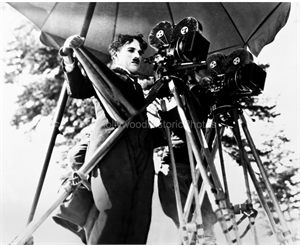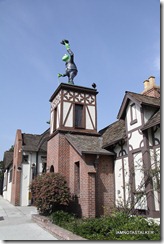No video provided.
The Chaplin-Henson Studios
Thanks to the advent of cinema, the legendary Charlie Chaplin is forever immortalized as a comedic genius dressed as a funny little man with a goofy walk, bowler hat, bamboo cane and a toothbrush mustache. Born in London in 1889, Chaplin quickly made a place for himself in vaudeville theatre whose popularity brought him and his vaudeville troupe to the United States. When his contract expired in 1913, he began working in early films at $150 a week becoming an overnight success with many offers for his services. Before he was 30, he was one of the most famous men in the world and a pivotal character in the silent film era of early Hollywood.

Chaplin at work
Wanting more freedom from the studio heads and producers and contracts that controlled actors, Chaplin set his heart on the idea of building his own studio. In 1917, independent theatre owners in the United States came together to create the First National Exhibitors’ Circuit, Inc. becoming the country’s largest theater chain. In order to work with First National, Chaplin needed a studio. In October 1917, he announced plans to build his own film studio at the southeast corner of La Brea and Sunset Boulevard.
Chaplin purchased the site on the corners of La Brea and De Longpre Avenue from R.S. McClellan, who lived on the property and owned a large orange grove. The Chaplin family home would be on the northern part of the property which would be the motion picture plant. Since the property was in a residential neighborhood at the time, many residents opposed the idea of a movie studio in their neighborhood claiming it was much too close to Hollywood High School. However, the City Council approved Chaplin’s permit and in November 1917, construction began for a reported $35,000. He believed that he had built the perfect location with a developing plant, cutting room and offices.
In January 1918, Los Angeles Times motion picture editor Grace Kingsley and cartoonist Edmund Waller “Ted” Gale visited Charlie Chaplin’s new studio. They described the building as a camouflaged English street while other writers described it as “eccentric Peter Pan architecture.” The studio was disguised as a picturesque cottage to appease the local residents. Though a large private residence was located on the northern end of the property along Sunset Boulevard, Chaplin never lived there, though his brother and other studio personnel did. The English cottage-style buildings along La Brea held the studio offices, a screening room and a film lab. The center of the property housed two large outdoor sets and a backlot while dressing rooms, a garage, a carpenter’s shed, film vault, tennis courts, swimming pool and stables made up the rest of the five-acre property.
Charlie Chaplin Studios released its first film, A Dog’s Life, with First National in April 1918. In 1919, together with Mary Pickford, D.W. Griffith and Douglas Fairbanks, Chaplin created United Artists, the first studio allowing actors to control their own interests. His studio was the location of many of Chaplin’s greatest films including The Kid, The Gold Rush, City Lights and The Great Dictator. In 1928 and 1929, La Brea Avenue was expanded and forced the buildings along the street to be relocated 15 feet back from their original sites. In the mid-1930s, the open-air stages were converted to closed soundstages and a smaller stage was built over the location of the studio swimming pool. In 1942, Chaplin sold the northern portion of the property, including the private residence, tennis courts and a portion of the backlot, and a shopping center was built in its place. Chaplin Studios was well known as a sacred location for Charlie Chaplin who never permitted outsiders to work there. However, in 1943, Columbia Pictures was permitted to shoot Curly on the studio lot. The studio is said to be the location of Greta Garbo’s last screen test in 1949 and the last Chaplin film to be made on the lot was The Limelight in 1952. With America at the peak of Cold War paranoia as well as sex scandals and other political agendas at a high, Charlie Chaplin left the United States in 1952 and sold his studio in 1953.
The new owner planned to tear down the studio, but fortunately it was leased to a television production company where it became the home of The Adventures of Superman, The Red Skelton Show, and Perry Mason, among others. In 1966, Herb Alpert and Jerry Moss purchased the studio for the headquarters for A&M Records. Alpert and Moss rebuilt the old soundstages into what they described as the most luxurious and pleasant studios in the world. During its time as A&M Records, the studio was host to multiple musicians’ recordings and videos including The Police’s music video for Every Breath You Take and both versions of We are the World with music legends. In 1969, the Los Angeles Cultural Heritage Commission designated the studio Historical Monument No. 58, noting that the property was one of the few locations from old Hollywood that had retained its early production layout. At the time, the studio was only the second entertainment-related building to receive the designation after Grauman’s Chinese Theater.

Henson Studios today.
Puppeteer Jim Henson had built a dynasty creating a cast of characters beloved by generations until his untimely death at the age of 53 in 1989. In February 2000, the late Jim Henson’s children purchased the studio to serve as the new home of The Jim Henson Company. Lisa Henson thought that the buildings were a lovable hodge-podge of quirky unusual spaces and believed that it may not be a location typical for corporate offices but felt that it was the right location for the Muppets. Henson’s son, Brian Henson, said that Chaplin’s studio was the perfect home for the Henson’s brand of classy but eccentric entertainment. Although the Muppets now belong to Disney, the studio currently holds the Henson Recording Studios and the Henson Soundstage as well as the corporate headquarters for the Jim Henson Company and Jim Henson Creature Shop, a special/visual effects company.
The statue atop the entrance serves as one of the few reminders of the man who built the studio 100 years ago. The last time Charlie Chaplin saw the studio was when A&M still owned it. He quietly drove by the studio gates in 1972, when he visited the United States to receive an honorary Oscar award. Charlie Chaplin passed away on Christmas day in 1977 at the age of 88 in his family home in Switzerland. The legacy that he left in the entertainment world lives through his films and the small studio declared a historic monument. Not an ending but a perfect continuation, now memorialized as a 12-foot Kermit the Frog statue dressed as Chaplin’s character “The Tramp,” a fitting tribute to two legends of the entertainment industry. DH